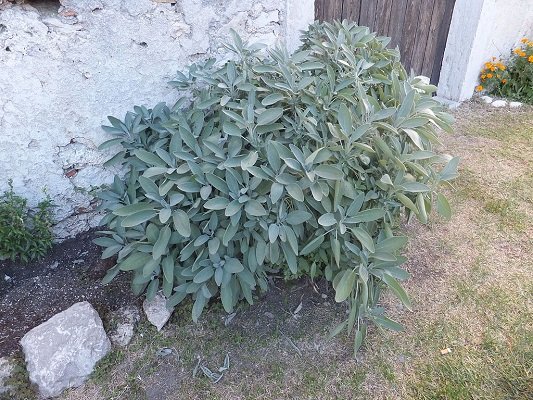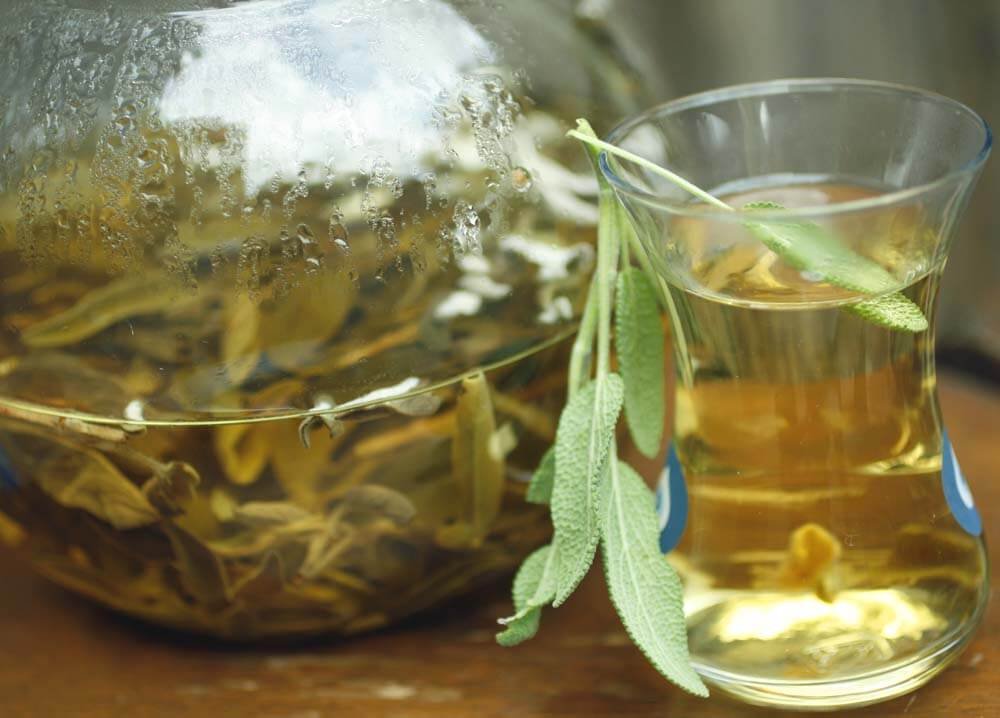Sage Tea (Salvia): Benefits, Therapeutic Properties, And Side Effects

In this article, we are talking about Sage (Salvia Officinalis) and its benefits, therapeutic properties, and potential side effects. We are also providing some sage tea recipes that will help you boost your health. The properties of sage will delight you. It is a plant with many uses, from cooking to beauty.
Name: Sage
Scientific name: Salvia Officinalis
Family: Lamiaceae
Other names: Salvia, garden sage, common sage, or culinary sage
What is Sage
Sage is a shrub or tree bush, native to southern Europe and the Mediterranean countries that have been introduced relatively recently and it self-grows in some parts of Central Europe.
Sage is very widespread in Greece that the French call it the “tea of Greece”. Sage is mainly found in Southern Greece (Peloponnisos-Islands), but generally, there are over 20 species of sage in Greece. The most widely sage species found in Greece is Salvia fruticos. Sage prefers sunny areas and rocky, barren soils.
Sage is one of the most charismatic and ”rich” herbs – not only in Greece but everywhere around the world that it’s been cultivated.
In Mount Athos, you can find it planted in all the courtyards of the cells and monasteries since it is an essential remedy but also an excellent decoction for the whole winter. In some monasteries, there is now systematic cultivation and drying of this charismatic plant.
Its height reaches 20-60 centimeters. The lower part is woody. The upper surface of the square branches is covered with velvet coat.

The leaves are 3-10 cm long and 1.5-5 cm wide. They are large, opposite oval and elongated, with gray-green color. The flowers are bright blue to violet-blue with a length of 2-3 cm, with a small upper lip, and are found in circular inflorescences, in groups of 4-8.
The plants usable parts are mostly the leaves after drying in shade but also the flowers as well.
The leaves are collected just before or at the beginning of flowering in dry and sunny weather, in May or June. Drying should not exceed 35 degrees Celcius.
Sage Ingredients
Sage contains volatile oil containing 30% thujone, 5% cineol, linalool, borneol, camphor, salven, and pinene, a bitter element, tannins, triterpenoids, flavonoids, estrogens, and resin.
This plant, which has a strong and aromatic smell and a warm, bitter taste, contains 2% green essential oil, similar to that of wormwood.
History And Tradition
Sage has been used since ancient times. The ancient Greeks considered it a sacred plant and had dedicated it to the god Zeus. Women in ancient Greece welcomed men from war with a sage drink to “stimulate” fertility.
The ancient Egyptians gave women to drink sage to increase their fertility.
The Arabs were asking themselves: “How can a man die when he has sage in his garden?” – that much power they considered the herb to be that they thought it could cure everything.
The great properties of sage are exceded by Theophrastos, Hippocrates, Dioskourides, Galen, Aetius, etc.
The Latins called sage, a sacred plant (herba sacra). They considered it the sacred plant of immortality and used it in ceremonies, while those of the School of Salerno said of sage that there is no other, better medicine against death.
The Chinese, to whom the Dutch met sage, appreciated it so much that they would barter two or three tea boxes of their own with 1 box of sage.
Sage: Therapeutic Properties
- The most remarkable therapeutic virtue of sage is that it prevents sweating (this action begins 2 hours after intake of the drink and can last many days).
- Also has antibiotic, antifungal, antispasmodic and hypoglycemic action (research).
- Stops milk production, is antiphysical, spasmolytic, tonic, antidiarrheal and has an estrogenic effect.
- Exercises mucous action (cough, sinusitis).
- As an astrinstic, stimulant, and tonic, it causes heat in the stomach, facilitates digestion, causes diuresis, accelerates circulation, exerts a significant effect on the brain, and as an antispasmodic and soothing drug, mitigates irritation of the nervous system.
- It is the strongest progestogenic herb, useful therefore, in the symptoms of menopause and dysmenorrhea (menstruation), especially in sweats.
- Sage in the form of an decoction is ideal for the healing of the mouth in case of injuries, foams, pharyngitis and against gingivitis.
- It stimulates the nerves, adrenal glands, and circulatory system. Recommended for any form of atony and weakness, nervous weakness, tremor, vertigo, and neuralgia.
- Acts against sugar, rheumatism, gout and diarrhea.
- Sage thanks to the action of antioxidants has the ability to extinguish free radicals produced in humans by various mechanisms and which are responsible for many chronic diseases.
- Stimulates and rejuvenates tired and sore muscles. Relieves cramps.
- The oil or dried leaves are added to the hot water and become gargle. This particular herb has anti-inflammatory properties and provides a relaxing feeling in the throat.
- Sage (mainly sage essential oil) improves memory and the information processing process. According to research published in the Journal Of Pharmaceutical Chemical Behavior, it was found that people with Alzheimer’s disease would be good to have sage in their diet.
- It’s said to sharpen the intellect and especially the perceptiveness.
Related: How to Tell if Essential Oils Are Pure
Other Uses of Sage
- Sage is beneficial for the hair if we use it during the rinsing process. It improves the color of dark and gray hair. Stimulates and shines on the dry and sensitive hair (source).
- In cooking, it is used for the aromatization of various broths, food, and vinegar
- It is also considered a beekeeping plant providing honey of vintage quality. (Honey made from sage)
- The foot bath with sage infusion cools and exerts deodorant action.
- Helps in bites from mosquitoes and wasps, rubbing with the fresh leaves of sage, the irritated spot.
- Sage is styptic, like a mask on the face.
- As a cosmetic is recommended for oily skins, as a mask for deep cleansing of the face, and as a steam bath.
- Its antioxidant action makes it useful in the food industry since it is conservative and replaces synthetic preservatives, in the production and packaging industries of cheese products, vegetables, processed foods, and soft drinks.
- Sage is also used in perfumery (source).
- Its taste is quite peppery and fits very well with fatty meats and cheeses. It also matches fish and seafood.
- As a stimulant of erotic mood put 80 grams of sage leaves in a liter of good black wine for a week and drink a little every day or use sage oil in a diffuser for aromatherapy. (source, source)
How to Use Sage
Infusion
Pour a cup of boiling water into 1-2 teaspoons of leaves and leave for 10 minutes, then strain. You drink three times a day.
Tincture
2-4 ml of tincture three times a day.
Oral washes
Add 2 teaspoons of leaves into 1/2 liter of water, boil it, then remove from the heat and leave covered for 15 minutes. Gargle deeply with the hot drink for 5-10 minutes, several times a day.
Drenching
Add 80 g. leaves within 1000 g. of black wine and let them soak for 8 days. Take 1-3 tablespoons daily after eating.
Sage tea
The simplest way to enjoy the benefits of sage is to make tea! Just pour about a cup of boiling water over a tablespoon of sage leaves and let them soak until the tea is as hot as you like. Then drain the leaves.
However, you can also make a more refined (and particularly tasty!) version of this tea with the recipe below, combining fresh sage leaves with lemon and a little sugar.
Sage Tea Recipe

Sage tea is a natural caffeine-free beverage and you can enjoy it hot or chilled at any time in the day or night.
Materials
- 14 grams of fresh sage leaves (get here) (about 45 leaves; most marketed herbs usually weigh 21 grams) and a
- sweetener of your desire. We recommend stevia, coconut sugar (get here), maple syrup (get here), or honey.
- 7 grams grated or finely chopped lemon peel (about 1.5 teaspoons grated or 1 tablespoon finely chopped or the peel of a large lemon)
- Lemon juice (about 3 tablespoons)
- 4 cups water
Preparation
- As you prepare the remaining ingredients, boil the water.
- Let the water simmer and add the remaining ingredients.
- Allow the ingredients to soak for 20 to 30 minutes, stirring occasionally.
- Drain the sage leaves and serve the tea warm or refrigerate and serve frozen.
☝️ Be careful not to overdo it. Excessive use of sage can be toxic to your body.
Sage and Candida
Sage can fight effectively candida infections such as candida Albicans, candida krusei, candida pseudotropicalis , candida glabrata and cryptococcus neoformans, as well as inflammation and infections of the mucous membranes of the mouth, gums, and pharynx (source).
To use sage’s healing property, all you need to do is gargle. Place a few sage leaves in a cup of hot water and leave for 20 minutes. Strain, allow to cool and gargle every three hours.
However, if you suffer from Candida, the above sage recipe, of course, is not enough to deal with it permanently. You will need to modify your diet and change your lifestyle.
Sage Precautions and Side Effects
- Large quantities of sage cause toxic phenomena.
- Sage stimulates the muscles of the uterus, so it should be avoided during pregnancy.
- In large doses, it increases blood flow to the underbelly organs and is probably harmful to the nervous system.
- Sage should be avoided by hypertensive and blood-causing individuals as well as children due to its stimulating effect. It should not be taken continuously for more than two weeks due to the possible toxic effects of thujone essential oil.
- Its use should be done wisely because there are cases of poisoning from excessive use due mainly to the substance thujone present in the plant.
Conclusion
Sage is a herb used and respected from the ancient times for its therapeutic properties, from major civilizations around the world.
Sage must not be absent from anyone’s house as it can heal and offer so much to you and your loved ones.
If you feel that sage’s benefits and its therapeutic properties is something that more people should be aware nowadays, then feel free to share this article.
Read Next
